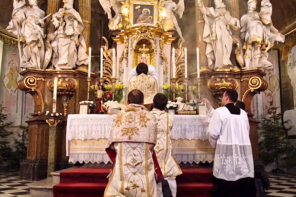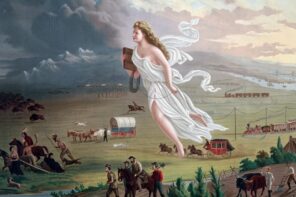The upcoming 60th anniversary of the Second Vatican Council, better known as Vatican II, will produce lots of hot takes on the famous mid-twentieth century gathering of the Catholic hierarchy. Most will ask: what went wrong? Why was the Catholic Church unable to capitalize on what Pope John XXIII called this “new springtime” for the church, as Catholicism instead sees a winter—at least in the West.
George Weigel, a senior fellow at the right-wing Ethics and Public Policy Center and author of Witness to Hope, the bestselling biography of Pope John Paul II, gives us his answer to that question in his latest book, To Sanctify the World: The Vital Legacy of Vatican II.
Despite his long history of conservative activism, Weigel attempts to position himself as a reasonable broker between what he says are two ideologically driven views of Vatican II that obscure its true meaning. On one hand there are those who claim that it was a “catastrophic mistake,” and “a concession to the modern world that should be repudiated”—a group referred to as Traditionalist Catholics that includes, presumably, the Dimes Square Catholics with their Latin Mass and chapel veils.
On the other hand, and equally mistaken, says Weigel, are those who believe that Vatican II ushered in a “Brave New Catholicism” that invited a reinvention of the Church. This would clearly be wrong, he says, because it would make Catholicism just “another liberal Protestant denomination,” which is the standard conservative critique of an expansive view of Vatican II.
Weigel claims that Vatican II has been misinterpreted because most people don’t understand its original intent. Of course, not only does his attempt to reframe the purpose of Vatican II conveniently align with a litany of conservative complaints about the twentieth century, but it also undercuts its revolutionary intent. And it’s a solution in search of a problem as it’s not widely disputed that the point of Vatican II was aggiornamento or the “bringing up to date” that Pope John cited. In his opening address, he plainly stated that the purpose of the Council was the “modernization of the Church after 20 centuries of life.”
As James Carroll recently wrote in the New Yorker, Vatican II was “an historic reversal of the Church’s panicked nineteenth-century repudiation” of the encroaching modern world. As such, it represented the church’s embrace of “pluralism, the separation of church and state, the primacy of conscience, the preference of experience over dogma, and—for that matter—freedom of the press.”
But according to Weigel’s revisionist history, Vatican II wasn’t a call to evolve the Church to respond to the modern, but a response by the Church to the rising tide of secularism in late nineteenth- and early twentieth-century Europe. In his view the certainties of Christendom had been “deconstructed” by a litany of evils, including Darwin, Freud, “atheistic humanists,” and “advances in physics and astronomy that reconfigured humanity’s sense of its place in the cosmos.” (Notably, many of these advances reflect the increasing participation of Jews and Jewish culture.)
These evils, according to Weigel, made religious faith “a conscious decision” rather than a cultural inheritance, which in turn led to a “Promethean narcissism that has led to the self-destructive cataclysms” of the First and Second World Wars and the Cold War.
Weigel’s simplistic and self-serving reading of twentieth century history allows him to frame his contention that the real purpose of Vatican II wasn’t modernization but “evangelism.” In addition, Weigel doesn’t define this as a joyful proclamation of the gospel to the outside world, as Pope John suggested, but as a reassertion of a “biblical view of the human person” into politics, art, entertainment, science, and culture.”
This isn’t surprising coming from Weigel, who was one of the signers of the Manhattan Declaration calling for a muscular conservative Christian presence in public policy and lawmaking. It was Weigel who coined the phrase “Evangelical Catholic,” which he defines as “a counterculture that seeks to convert the ambient public culture by proclaiming certain truths”—such as the absolute immorality of abortion or the right to discriminate under the cover of “religious liberty”—a counterculture that “does not seek to ‘get along’; it seeks to convert.” This evangelism, according to Weigel, requires Catholics to push for these particular Catholic beliefs to be converted into law, which, according to Weigel, is the only way to reverse the decline of the culture.
What, exactly, Catholicism demands of Catholics in the public square has always been a major sticking point between the conservative and progressive camps of Catholicism. In the wake of Vatican II, many Catholic politicians embraced the spirit of religious liberty put forth by the council in the Declaration on Religious Freedom, seeing in the robust separation of church and state a way to protect the beliefs of all.
When he was attacked for being a Catholic who refused to advocate for the recriminalization of abortion, New York governor and Democratic presidential candidate Mario Cuomo famously replied in a 1984 speech at Notre Dame:
My church and my conscience require me to believe certain things about divorce, birth control and abortion. My church does not order me—under pain of sin or expulsion—to pursue my salvific mission according to a precisely defined political plan.
By promoting this muscular “evangelism” that requires Catholics to push for Catholic doctrine to be inserted into law, Weigel appears to spin one of the major triumphs of Vatican II—the ability of Catholics to participate fully in the modern, even secular, world without necessarily imposing their faith on others, while still being free to proclaim it—into a roadmap for a kind of Christian nationalism. Call it Catholic nationalism.
According to Weigel, the reason that this evangelical message of Vatican II failed to be carried forth isn’t because that wasn’t what the council intended, but because of confusion in its implementation due to the “vast social, political, and cultural upheavals” of the 1960s and the weak leadership of Pope Paul VI, who failed to “enforce discipline” in the aftermath of Vatican II.
This failure to enforce discipline, of course, refers above all else to the rejection of Pope Paul’s Humanae Vitae encyclical banning modern contraceptives not only by bishops’ conferences but by much of the Western Catholic faithful. Tellingly, the Vatican’s disastrous attempt to hold the line on contraception receives precisely one mention by Weigel, despite the fact that it was this absolute disregard for the lives and experiences of Catholics that arguably did more than anything (at least until the sexual abuse scandals of the early 21st century) to cause a dramatic loss of faith in the Church’s moral authority.
Two geniuses
Weigel asserts that the biggest problem with the reception of Vatican II by Catholics was that there was no “key” to understanding the 16 separate and theologically dense documents produced by the Council—“an authoritative interpretation of that teaching” that could settle the “unresolved debate over what the Council actually meant.”
It was the interlocking papacies of archconservative popes John Paul II and Benedict XVI—Benedict having followed John Paul to the papacy after serving as his chief theologian and enforcer—that provided this “authoritative interpretation” according to Weigel. These “two men of genius” provided the “Council without keys”
with a “set of keys capable of unlocking the evangelical renewal of the Church that Pope John XXIII intended.”
Both had been prescient, according to Weigel, in diagnosing the ills of the 20th century church. In 1958, a young Karol Wojtyla warned about “’exaggerated’ humanisms” that caused despair, while one year later, Joseph Ratzinger warned darkly that the European Catholic Church was a “church of Pagans.”
He traces how these two geniuses used their official pronouncements to move church doctrine ever-rightward during the combined 35 years of their papacy, all the while insisting that they were simply reclaiming the true meaning of Vatican II.
Take, for example, the Council’s historic Declaration of Religious Freedom, which declared the “right of the human person to religious freedom,” including the right to be free from government coercion of religious practice or belief. Weigel quotes approvingly from Wojtyla who said during the council that “the right of religious freedom must always be tethered to the responsibility to seek and adhere to the truth, including the truth about God.” In other words, religious freedom must be oriented to the “truth”—as conservatives define it.
As Carroll notes, the papacies of John Paul II and Benedict—Weigel’s “keys”—were in fact an “ultraconservative blowback” to Vatican II, one that was “obsessed, above all, with issues related to sexuality and the place of women.” The all-male hierarchy, he says, “effectively turned the female body into a bulwark against the changes that Vatican II had embraced.”
Of course the teachings of John Paul and Benedict have been picked over for years by approving conservatives; there’s nothing new in Weigel’s rehash. Sanctify’s revisionist history of Vatican II suggests, despite the evidence, that the right-wing agenda of Weigel and other “Evangelical Catholics” actually has the imprimatur of history.
Still, you have to admire Weigel’s resourcefulness in positioning himself as a neutral broker in the battle over the meaning of Vatican II despite all he has in common politically with the Traditionalists who reject it. Recognizing that Traditionalists are fighting a lost cause, he’s opted to accept Vatican II and some of its more peripheral elements, and to focus instead on reshaping its intent to aid in his Christian nationalist vision. It’s a neat trick if you can pull it off.





